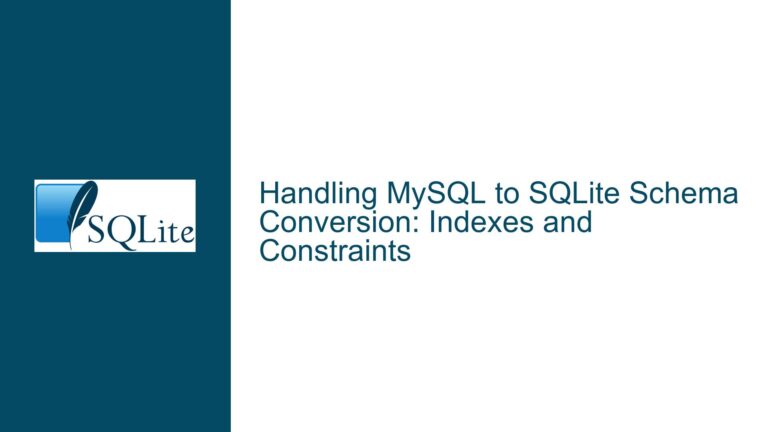CHECK Constraint Rejects Row-Value IN Due to Implicit Subquery
Row-Value IN Constraints Trigger Subquery Prohibition in SQLite CHECK
Understanding the Row-Value IN Constraint Syntax & CHECK Limitations
The core issue arises when attempting to enforce domain integrity via a CHECK constraint that validates combinations of column values against predefined tuples using row-value syntax with the IN operator. The specific error Parse error: subqueries prohibited in CHECK constraints indicates SQLite’s internal reinterpretation of the row-value comparison as a subquery operation, even when no explicit subquery is written.
In the example provided, the constraint (type, LENGTH(myblob)) IN ((0, 16),(1,4),(0,0)) is designed to restrict valid (type, myblob) pairs to those matching the specified combinations. However, SQLite parses the right-hand side (RHS) of the IN operator as a subquery due to syntactic sugar rules. The row-value IN syntax for multiple tuples is expanded internally into a VALUES clause, which SQLite treats as a subquery. Since CHECK constraints in SQLite explicitly prohibit subqueries (to avoid complexity and maintain deterministic behavior), this leads to a parse error despite the absence of an explicit subquery in the original SQL statement.
The confusion stems from the gap between SQLite’s documented support for row-value comparisons and the implicit transformation of multi-tuple IN lists into subqueries. The row-value documentation clarifies that the RHS of an IN operator with row-values must be a subquery. This creates a contradiction when developers attempt to use literal tuple lists in CHECK constraints, as these are converted to subqueries behind the scenes, violating the CHECK constraint’s restrictions.
Implicit Subquery Generation & Foreign Key Constraint Workarounds
The root cause of the error lies in SQLite’s syntactic expansion rules. When a developer writes (a, b) IN ((1,2), (3,4)), SQLite parses this as (a, b) IN (VALUES (1,2), (3,4)), which is equivalent to a subquery. This occurs even though the syntax appears to use a static list of tuples. The CHECK constraint parser detects this subquery structure and rejects it.
An effective workaround replaces the CHECK constraint with a foreign key constraint that references a lookup table containing valid (type, length) pairs. This approach leverages SQLite’s foreign key enforcement to achieve the same domain integrity without subqueries. By introducing a generated column (mybloblen) to compute the length of myblob and a foreign key constraint linking (type, mybloblen) to the lookup table, the original validation logic is preserved.
The lookup table allowtypelen explicitly lists permitted combinations, and the foreign key ensures referential integrity. The VIRTUAL keyword in the generated column definition ensures the length is computed dynamically without storage overhead. This method avoids subqueries entirely, complying with SQLite’s CHECK constraint limitations while maintaining the desired data validation.
Implementing Foreign Key-Based Validation & Avoiding Common Pitfalls
Step 1: Create the Lookup Table
Define a table to store valid (type, length) pairs with a composite primary key. Using WITHOUT ROWID optimizes storage and access for this table:
CREATE TABLE allowtypelen (
type INTEGER NOT NULL,
len INTEGER NOT NULL,
PRIMARY KEY (type, len)
) WITHOUT ROWID;
INSERT INTO allowtypelen VALUES
(0, 16),
(1, 4),
(0, 0);
Step 2: Define the Main Table with a Generated Column
Add a generated column to compute the length of myblob dynamically. The VIRTUAL keyword ensures the value is computed on-the-fly during inserts/updates:
CREATE TABLE mytable (
type INTEGER NOT NULL,
myblob BLOB NOT NULL,
mybloblen INTEGER GENERATED ALWAYS AS (LENGTH(myblob)) VIRTUAL,
CONSTRAINT coltypelen
FOREIGN KEY (type, mybloblen)
REFERENCES allowtypelen(type, len)
);
Step 3: Enable Foreign Key Enforcement
Ensure foreign key constraints are enabled in the SQLite session:
PRAGMA foreign_keys = ON;
Validation Logic Flow
When inserting into mytable, SQLite computes mybloblen as LENGTH(myblob) and checks if (type, mybloblen) exists in allowtypelen. If not, the insert/update fails. This enforces the same rules as the original CHECK constraint without subqueries.
Alternative: Expanding the CHECK Constraint
If avoiding a lookup table is preferred, rewrite the CHECK constraint using explicit logical conditions:
CREATE TABLE mytable (
type INTEGER NOT NULL,
myblob BLOB NOT NULL,
CONSTRAINT coltypelen CHECK (
(type = 0 AND LENGTH(myblob) = 16) OR
(type = 1 AND LENGTH(myblob) = 4) OR
(type = 0 AND LENGTH(myblob) = 0)
)
);
This eliminates the row-value IN syntax, avoiding subquery detection. However, it becomes unwieldy for many combinations and lacks the maintainability of the foreign key approach.
Critical Considerations
- Generated Column Overhead: Virtual columns incur minimal overhead but require SQLite 3.31+ (2020-01-22). For older versions, use triggers to compute
mybloblen. - Lookup Table Maintenance: Adding/removing valid pairs requires modifying
allowtypelen, which may be preferable for dynamic rules. - Foreign Key Limitations: Circular dependencies or cascading updates complicate foreign key usage. Ensure
allowtypelenis populated before inserting intomytable.
By understanding SQLite’s parsing behavior and leveraging its foreign key system, developers can enforce complex domain constraints while adhering to the engine’s limitations.






